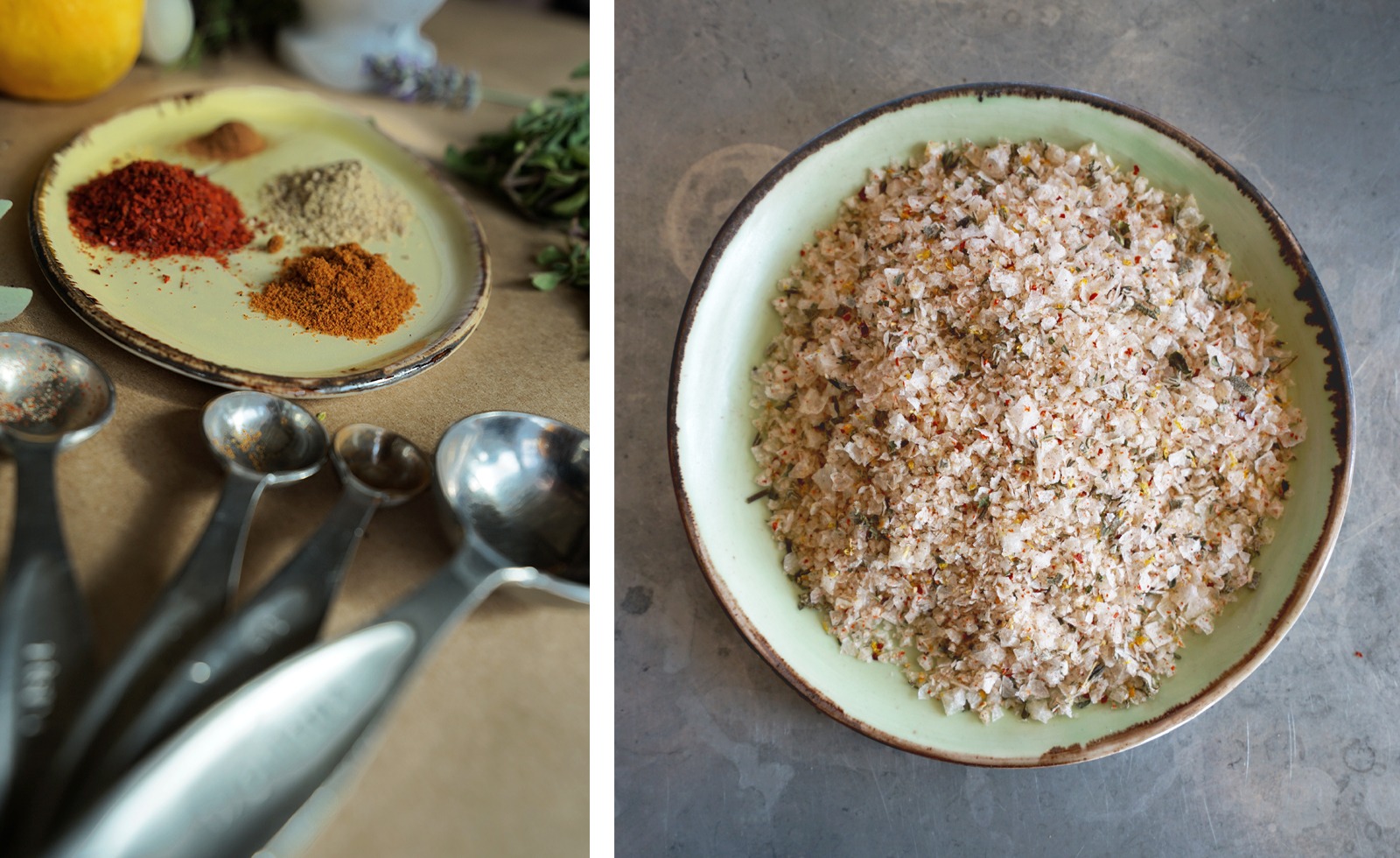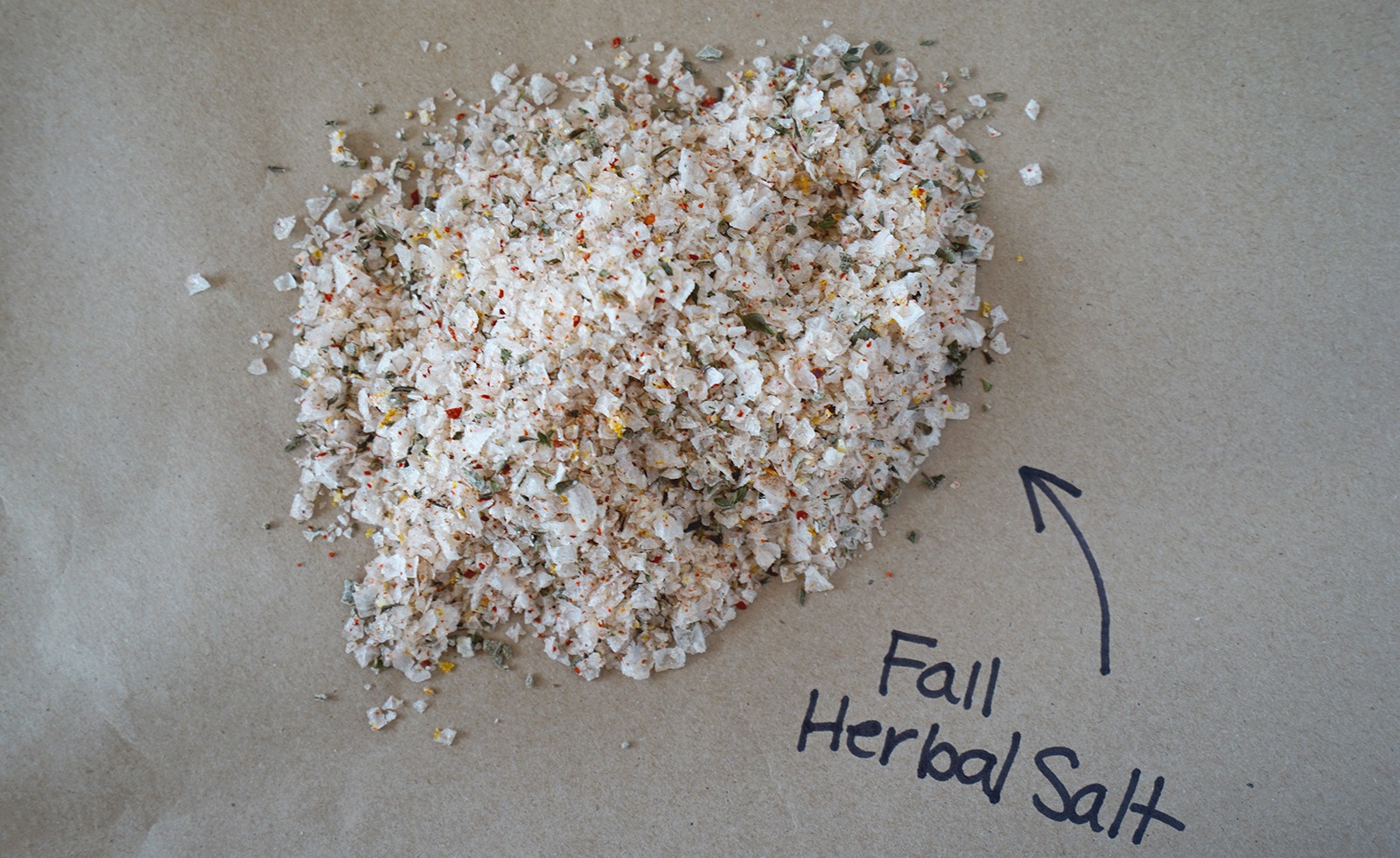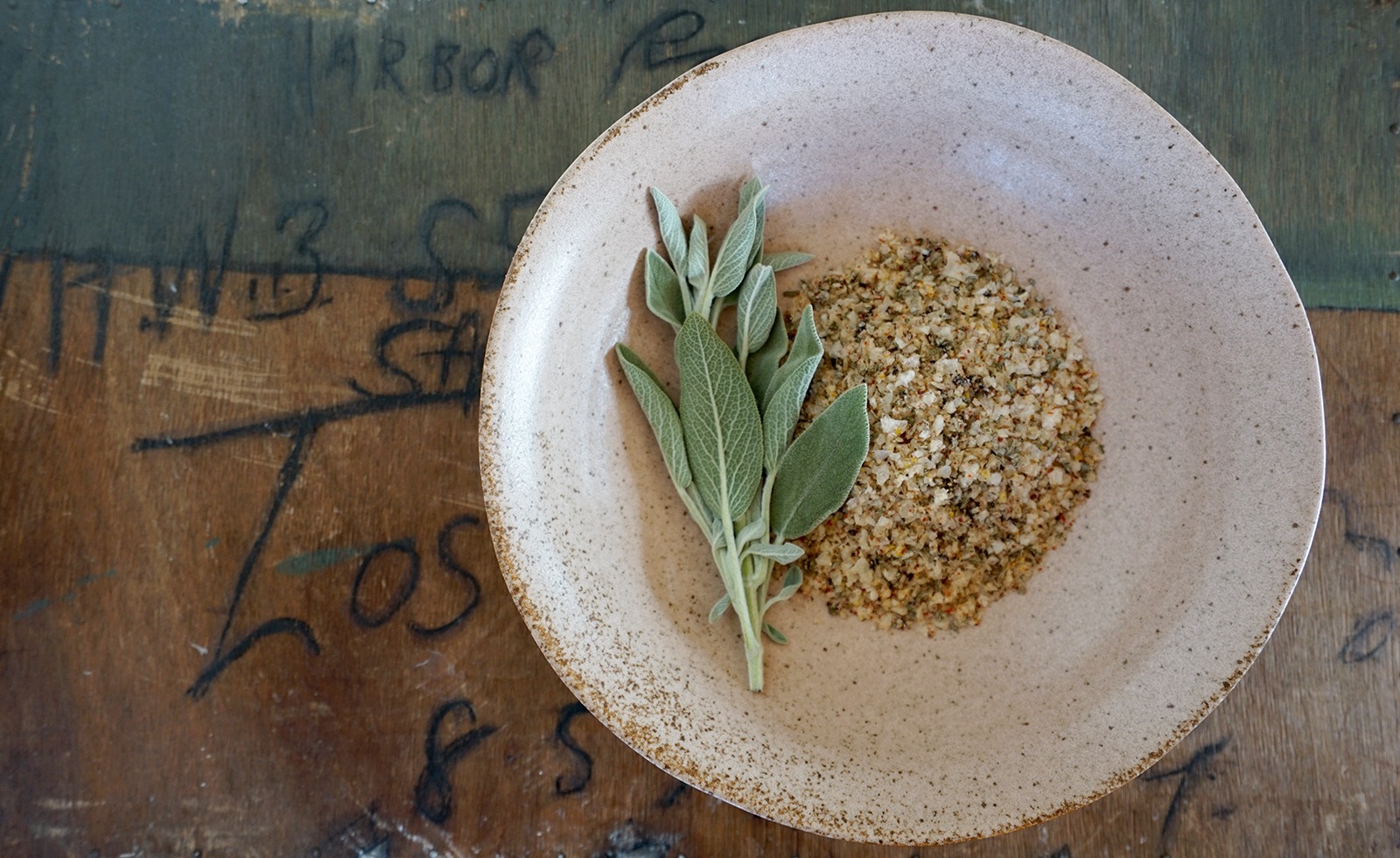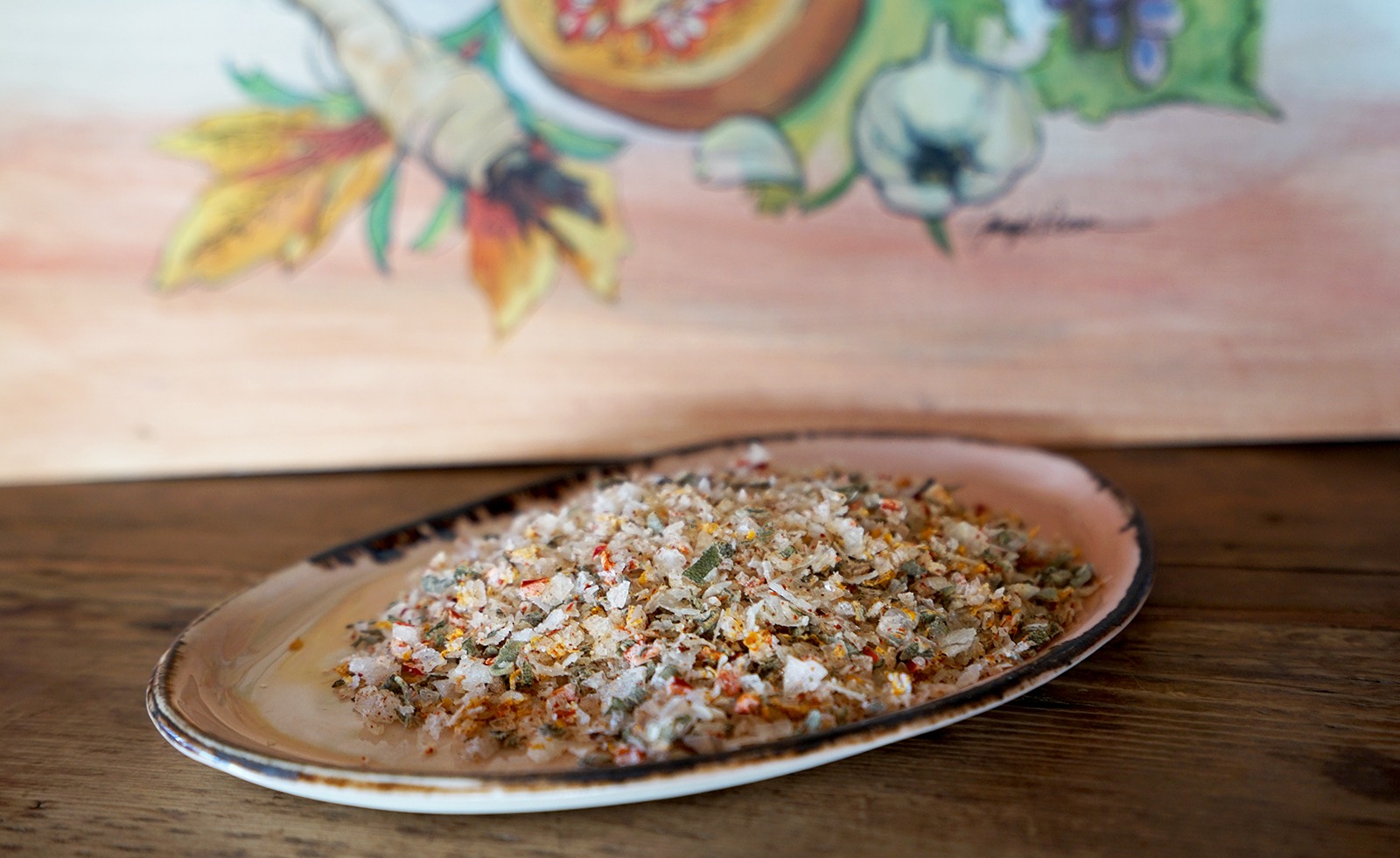Thanksgiving Herb Salts
NOVEMBER 23RD 2019
Sage is without question the herb of the season. It’s hard to see, smell or taste, without thinking about the warming and comforting foods of fall, that start to bring us inside, literally and figuratively. As we begin to settle into the rapidly colder and darker winter, sage creeps into our foods; in soups, beans, stews and most importantly buried throughout most of the dishes on our holiday tables. Just as pumpkin pie spice is synonymous with fall, sage is tantamount to Thanksgiving. There is nothing more quintessentially Thanksgiving than sage, except I suppose the turkey.
Sage is technically a member of the mint family and is an evergreen shrub. It produces prolifically in fall, after the summer heat dissipates. It has light greenish-grey textured leaves and a very pungent aroma. Its flavor is earthy, smoky and strong. Americans are only beginning to delve into the beauty and mystery that is culinary sage.

It’s been most widely used, until lately, in Italian cuisine and Thanksgiving foods like stuffing. As more and more chefs, home cooks, food bloggers and consumers get their hands on it and play, and as those ideas spread via the internet, we see lots of new recipes and ideas emerging. An array of uses for sage are popping up in sweets and baked goods, cocktails and mocktails, fruits and vegetables and in various forms in meats and sauces. I’d say it’s one of the herbs that’s “taking off” and I presume that’s because it’s versatile and multi-dimensional. Its potency is easily alterable and it blends well with other herbs. The robust flavor can be tamed a bit when either blended with other herbs or cooked. It is one of my favorite herbs, but I use it specifically and sparingly. It has an incredible smoky quality, that I love, that I think can easily be coaxed out further when paired with other smoky ingredients- Mezcal, BBQ’d stuff, dried chilies and dried spices -especially fall pie spices. It has been one of the most enjoyable herbs to experiment with as I continue with my herbal salt fetish.

There was never a doubt that my Fall Herb Salt would be sage-centric. I gave it the starring role, but its blending qualities allowed me to use a bounty of other fall herbs and create a salt that felt not only fallish, but very Thanksgiving-esque. The accompanying spices to my Fall Herb Salt; cinnamon, mace, white and Aleppo pepper contribute warmth and flavor and together with the sage the end result is an incredibly functional finishing and seasoning salt that goes with just about everything for Thanksgiving.
Sage had me so revved up, that I couldn’t stop with one salt, especially as I geared up to cook for three different fancy Thanksgiving themed event this year, including my own Thanksgiving, which I will be cooking in my own home for the first time in a long time.

Fall Herb Salt
Makes 2 cups
This autumnal salt has a warm, earthy flare to it. The woody stemmed herbs that pounce out of the ground in early fall are as present as the softer stemmed sultry marjoram. Tinges of mace and cinnamon give spice and added warmth while the orange zest locks in some freshness. It’s as if Thanksgiving has invited itself to your meal. The tinge of fresh lavender flowers, for slight floral essence, is optional.
Ingredients
1 tablespoon chopped super fine sage leaves
1 tablespoon chopped super fine marjoram leaves
1 tablespoon chopped super fine rosemary leaves
1 tablespoon chopped super fine thyme leaves
2 teaspoons fresh lavender flowers or ¼ teaspoon dried (optional)
1 ½ teaspoons Aleppo pepper
2 teaspoons finely cracked or ground white pepper
¼ teaspoon ground mace
¼ teaspoon ground cinnamon
1 tablespoon orange zest
1 ½ cups Maldon flake salt
Directions
Preheat oven to 200 degrees F.
Mix together all of the fresh herbs, spices, and zest in a medium mixing bowl. Gently fold in the salt. Use your fingers to mix well, making sure the herbs and spices are well incorporated into the salt. Spread the salt-herb mix evenly and flat across a baking sheet covered with parchment paper. Place sheet in the oven and bake until the herbs seem to have lost most moisture but still appear greenish, about 15-20 minutes. They should not be totally dried out. Store in a small bowl on your counter for a few weeks.

Sage Umami Salt
Makes 1 cup
Sage is one of my favorite herbs. Because it is ultra-potent, most of the time I believe we should use it sparingly. This is not one of those times. This salt becomes even more bold alongside black garlic and smoked salt. It’s one of my favorite salts for meat and poultry during the fall and winter season. It’s equally amazing on other foods, too. Black garlic, which is essentially an aged garlic, is what gives this salt an earthy umami punch. (Black garlic is super sticky, so it can be hard to chop finely because it clumps together – kind of like cubing cold butter.) It’s still potent but with a subtle sweetness that cuts the sharp garlic bite of fresh garlic. Sage also has a pungent umami essence, and pairing these two together makes for a more autumnal unami flavor. The other spices and orange zest just round it out.
A charcoal-grilled, bone-in rib-eye steak in the dead of winter, first rubbed with this sage umami salt, makes me very happy.
Ingredients
3 tablespoons chopped super fine sage leaves
1 teaspoon Aleppo pepper
1 teaspoon cracked fine long pepper (optional)
2 teaspoons finely cracked white pepper
1 teaspoon smoked salt, Alderwood or Cherry
2 teaspoons orange zest
4 medium cloves black garlic, chopped super fine (it will clump a bit)
1 cup Maldon flake salt
1 teaspoon maple syrup
Directions
Preheat oven to 220 degrees F.
Mix together all of the fresh herbs, spices, zest, and black garlic in a medium mixing bowl. Gently fold in the salt and then the maple syrup. Use your fingers to mix, making sure the herbs and spices are totally incorporated into the salt. The black garlic in particular needs to be pulverized into the salt with your fingers, as its super sticky and likes to clump. (Note: some of the clumps will dry out in the cooking process, and you will use your fingers again to pulverize them).
Spread the salt-herb mix evenly and flat across a baking sheet covered with parchment paper. Place in the oven, and bake until the herbs seem to have lost most moisture, about 20 minutes. Turn off the oven, and let the salt cool totally in the oven. Once it is cool, remove from the oven. Again, begin to pulverize the black garlic clumps more, and mix them into the salt. Store in a little bowl on your counter top for a few weeks.

Cinnamon Sage Salt
Makes 1 cup
I needed a little finishing salt for a holiday appetizer I did for an art opening at the Bolinas Museum. My Fall Herb Salt, didn’t feel right, I wanted more sage potency and essence of the holiday as well as something that felt sweeter and savorier -simultaneously. It was going to top a maple roasted butternut squash, whipped orange honey goat cheese Danish with whiskey caramelized onions. I wanted the salt to melt in one more pop of flavor. This was the result. It’s sage and cinnamon forward and heavy on orange zest. I’m thinking it will be great in my maple pumpkin pie tart crust!
Ingredients
3 tablespoons chopped super fine sage leaves
1 teaspoon Aleppo pepper
2 teaspoons white pepper, finely cracked
2 teaspoons ground cinnamon
2 teaspoons orange zest
Directions
Preheat oven to 200 degrees F.
Mix together all of the fresh sage, spices and in a medium mixing bowl. Gently fold in the salt. Use your fingers to mix, making sure the herbs and spices are totally incorporated into the salt.
Spread the salt-herb mix evenly and flat across a baking sheet covered with parchment paper. Place in the oven, and bake until the zest seems to have lost most moisture, about 25 minutes. Take out of the oven and let the salt cool. Store in a little bowl on your counter top for a few weeks.



